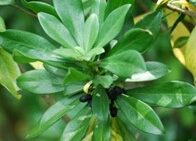By Lisa Kilder Clackamas Soil & Water Conservation District, The Mountain Times
As the soil softens with the early fall rain, it is the perfect time to pull Spurge Laurel. The control tasks you accomplish today will make your forest a better place in the spring!
This month the focus is on Spurge Laurel (Daphne laureola). This plant, in the Daphne family, is native to Europe. It was introduced in Oregon as an evergreen landscape plant but quickly fell out of favor due to its aggressive growth habit. Unfortunately, it naturalized in woodlands and is found in the forest understory. It is a perennial plant with poisonous berries and is aggressively spreading in the forests in Clackamas County.
Spurge Laurel is listed as an Oregon Class B noxious weed. This means it is a weed of economic importance and the propagation, transport, and sale of this plant is prohibited by law.
Why Should I Worry About Spurge Laurel?
Spurge Laurel displaces the native vegetation needed by wildlife for food and shelter. It grows in thickets and competes with native vegetation in the forest understory. This prevents the regeneration of native trees in our natural areas, harming the native habitat needed by our local wildlife. Spurge laurel is a significant threat to rare oak woodland ecosystems.
The plant reproduces through seed germination but can also spread locally from underground roots. Birds and rodents spread spurge laurel seeds when they consume the berries whose seed passes through the animals unharmed. The random distribution of the seeds by these animals make detection difficult, allowing spurge laurel to spread into natural areas.
It is important to note that the sap of Spurge Laurel is toxic to humans and can cause severe rashes and skin irritation in sensitive individuals. Wear protective clothing and gloves when handling this plant. Sap can also disperse into the air, causing breathing and respiratory problems. Remember, the bark, leaves, and berries are toxic to humans and most pets.
How Do I Identify Spurge Laurel?
Spurge Laurel is an evergreen, shade-tolerant shrub that grows 2-4 feet high. Adult plants form dense patches. Young branches are green, while older branches turn gray with age. Mature plants have many shoots, with most, if not all, originating near the base of the plant.
The plant has glossy, narrow, spoon-shaped, dark green leaves between 2-7 inches long and half an inch to two inches wide, arranged in a spiral around the stem. The leaves are densely clustered near the shoot tips. The shrub has small green to pale pink flowers that develop from the base of the leaves and bloom from late January to May. Berries are dark purple to black.
How Do I Control Spurge Laurel on My Property?
Control small infestations by hand pulling or digging up plants. All roots need to be removed to limit regrowth. Check the area at least once per year to remove any new seedlings that might emerge. Dispose of berries in the trash, but the remainder of the plant may go in yard waste bins.
Late fall into winter is the best time to remove the plants before the berries can spread: digging or pulling plants after a rain makes the job easier. A weed wrench or similar pulling tool will effectively remove larger plants. Borrow weed wrenches and similar tools free of charge from the Clackamas Soil and Water Conservation District. Call ahead about availability. 503-210-6000
The best way to control larger plants or dense infestations is to cut the shrubs off at ground level. Immediately treat the stump with an herbicide containing the active ingredient triclopyr to prevent regrowth. Read the herbicide label to be sure the product is suitable for use at the site. The label is the law.
Before beginning an herbicide treatment, contact the WeedWise program or consult the Pacific Northwest Weed Management Handbook for the most up-to-date recommendations.
Report Spurge Laurel
Have you noticed invasive Spurge Laurel in your area? If so, please report your sightings to the
District’s WeedWise program at 503-210-6000. You may also submit your information online to the Oregon Invasive Species hotline or call 1-866-INVADER.
Reporting locations of invasive weeds does not ensure enforcement. Instead, it provides landowners with information and assistance to control priority weeds. Controlling invasive weeds protects our local communities and can stop a new invasion before it starts!



